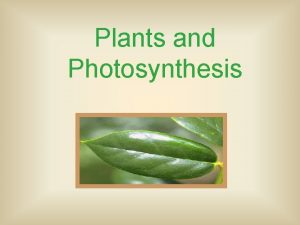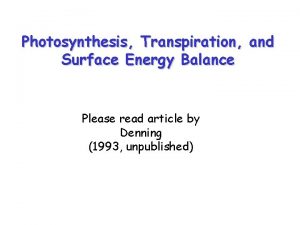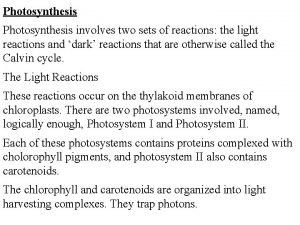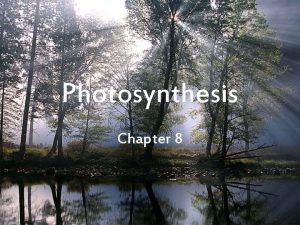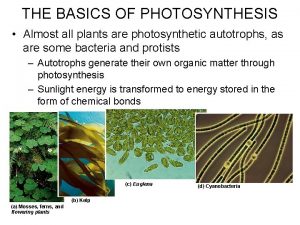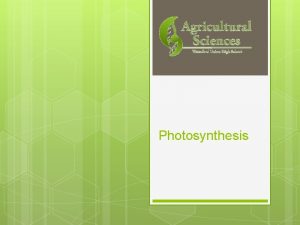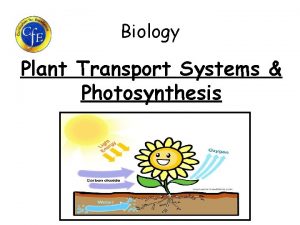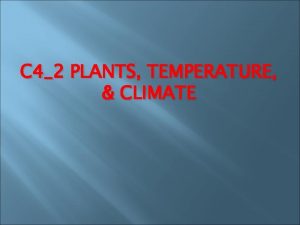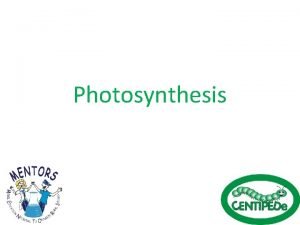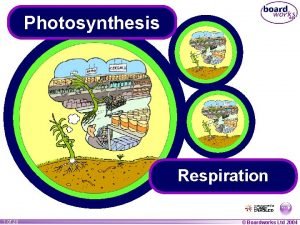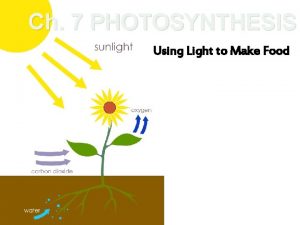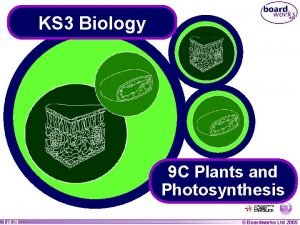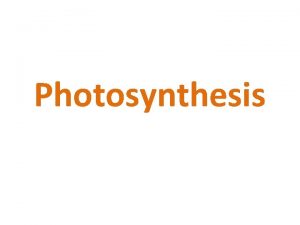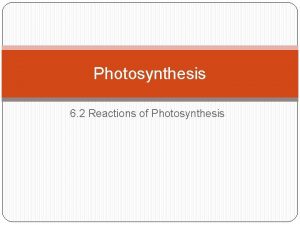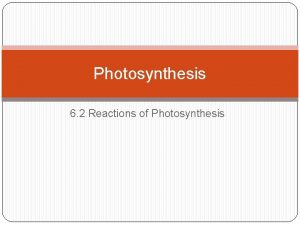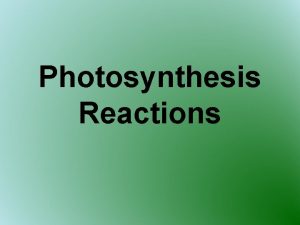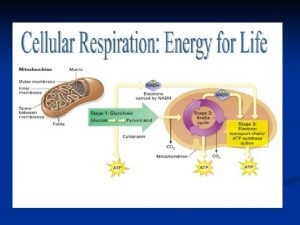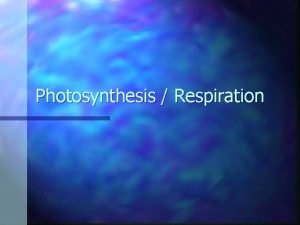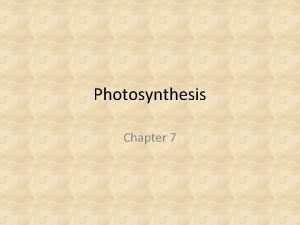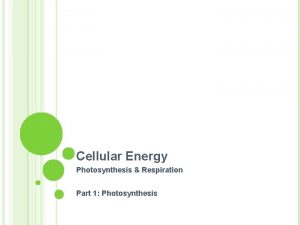Reactions of Photosynthesis I Reactions of Photosynthesis A





















- Slides: 21

Reactions of Photosynthesis

I. Reactions of Photosynthesis • A. Photosynthesis occurs in 2 parts – 1. Light-dependent reactions • a. take place in thylakoids – 2. Light-independent reactions (Calvin Cycle) • b. takes place in the stroma outside thylakoid

II. Electron Carriers • A. When sunlight hits chlorophyll in a chloroplast electrons become excited. – 1. When electrons become excited they are considered high-energy electrons • B. Electron carriers are like pans that transport a pair of high-energy electrons throughout the cell, this process is known as electron transport. – 1. Electron carries: NADP+

Where do they get the electrons that are excited? ? ? Water is needed for photosynthesis H 2 O O 2 + 2 H+ + 2 e. NADP+ + 2 H+ + 2 e- 2 NADPH

III. Light-Dependent Reactions “The Light Side” • A. These reactions require light • B. These reactions produce oxygen gas and convert ADP and NADP+ into the energy carriers ATP and NADPH.


III. Light-Dependent Reactions “The Light Side” • C. Along the thylakoids, antenna complexes made from chlorophyll a, b & carotenoids, gather light and send it to the reaction center that can excite electrons. What is e- acceptor? Donor?

III. Light-Dependent Reactions “The Light Side” • D. There are 2 types of reaction centers that differ on the type of chlorophyll & the wavelength they absorb – 1. Photosystem II (PS II) – P 680 maximum absorption is 680 nm. – 2. Photosystem I (PS I) - P 700 absorbs best at a wavelength of 700 nm • E. They are responsible for photophosphorylation (using light to make ATP)

IV. Noncyclic Photophosphorylation • A. Uses both photosystems. First photosystem II (P 680) absorbs sunlight splitting water into Hydrogen ions & excited electrons that are transferred to a primary acceptor when the electrons go down the electron transport chain to photosystem I. Some of the energy is used to pump hydrogen(protons) across the thylakoid membrane. – 1. The accumulation of hydrogen ions in the thylakoids create a proton gradient. As hydrogen ions move through membrane ATP is created. – 2. Photosystem I gains more energy with sunlight activating electrons to be passed to NADP+ to form NADPH


V. Cyclic Photophosphorylation • A. The simpler way to generate ATP. Only uses photosystem I(P 700) to excite electrons and are passed down the ETC to create ATP through the use of a hydrogen gradient. – 1. Does not create any NADPH & water is not split


VI. Light-Independent Reactions (Calvin Cycle) “The Dark Side” • A. These reactions do not require light and take place in the stroma

VI. Light-Independent Reactions (Calvin Cycle) “The Dark Side” • B. The Calvin cycle uses ATP and NADPH from the light-dependent reactions to produce high-energy sugars – 1. Since ATP & NADPH are not very stable and do not store a lot of energy – 2. The Calvin converts 6 CO 2 molecules into 1 molecule of sugar C 6 H 12 O 6 (carbon fixation)

VI. Light-Independent Reactions (Calvin Cycle) • C. Calvin Cycle: C 3 Pathway – 1. Ribulose bisphosphate (Ru. BP) combines with CO 2 to make unstable G 3 P to eventually make a six-carbon compound. (Ru. BP carboxylase, rubisco, catalyzes rxn. ) 6 Ru. BP + 6 CO 2 + 12 ATP + 12 NADPH convert 12 PGA to 12 G 3 P glucose molecule(2 G 3 P) + 10 G 3 P (back into 6 Ru. BP) drive Calvin cycle again + 12 ADP + 12 NADP+


VII. Photorespiration • A. When plants receive extremely bright light plants do not continue to grow due to photorespiration being triggered. • 1. Photorespiration leads to the fixation of oxygen. Ru. BP carboxylase reduces the CO 2 concentration to the point that it starts incorporating O 2 instead.

VIII. C 4: Alternative • A. Calvin Cycle: C 4 Pathway – 1. Plants found in extremely hot/dry conditions go through the C 4 pathway to fix CO 2 to glucose even when supply is low • B. Phosphoenolpyruvate (PEP) combines with CO 2 to form oxaloacetate, a four carbon molecule. (PEP carboxylase an enzyme that helps collect CO 2) – 1. This then is converted into malate which eventually changes form once more releasing CO 2 to drive Calvin cycle forward

IX. C 3 vs. C 4 • A. Similar: – 1. Occur in stroma – 2. Require ATP & NADPH – 3. Fix CO 2 to make glucose • B. Differences: – 1. C 3 uses a a 3 carbon molecule to begin making glucose while C 4 uses a 4 carbon molecule to initially make glucose

X. CAM Photosynthesis • A. Desert plants need to keep their stomates closed during the day to reduce transpiration. • B. CAM (crassulacean acid metabolism) photosynthesis uses C 4 with PEP carboxylase to fix CO 2 to oxaloacetate but instead of converting into malate its converted into malic acid which is placed into a vacuole and converted back into oxaloacetate and CO 2 to be used for Calvin cycle

XI. Factors Affecting Photosynthesis • A. Many factors affect the rate of photosynthesis that include: – 1. Water supply – 2. Temperature (0°C-35°C) – 3. Intensity of light
 Section 8-3 the reactions of photosynthesis answer key
Section 8-3 the reactions of photosynthesis answer key Autotrophs self-feeder
Autotrophs self-feeder Light and dark reactions of photosynthesis
Light and dark reactions of photosynthesis What are the two sets of reactions in photosynthesis
What are the two sets of reactions in photosynthesis Section 8-1 energy and life
Section 8-1 energy and life Inputs of light reactions in photosynthesis
Inputs of light reactions in photosynthesis Section 2 reinforcement classifying chemical reactions
Section 2 reinforcement classifying chemical reactions Chemical reactions section 3 reactions in aqueous solutions
Chemical reactions section 3 reactions in aqueous solutions Section 2 reinforcement classifying chemical reactions
Section 2 reinforcement classifying chemical reactions Unit 5 chemical reactions answers
Unit 5 chemical reactions answers Redox reaction
Redox reaction Photosynthesis in a nutshell
Photosynthesis in a nutshell Cuticle leaves
Cuticle leaves Photosynthesis transforms light energy into chemical energy
Photosynthesis transforms light energy into chemical energy Relative rate of photosynthesis
Relative rate of photosynthesis Importance of photosynthesis
Importance of photosynthesis What happens during photosynthesis
What happens during photosynthesis Photosynthesis in a sentence
Photosynthesis in a sentence Is photosynthesis a redox reaction
Is photosynthesis a redox reaction Chapter 9 lesson 2 photosynthesis an overview
Chapter 9 lesson 2 photosynthesis an overview Photosynthesis equation
Photosynthesis equation Photosynthesis poem
Photosynthesis poem

